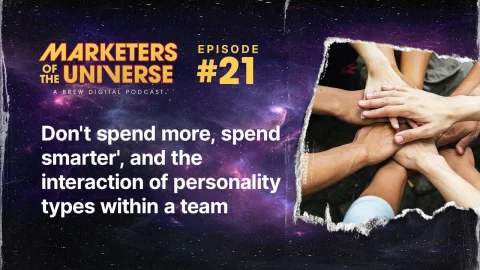Unless you're blessed with unlimited access to money, it's highly likely that you are expected to operate within a budget. More importantly, we're willing to bet that you have some lofty ROI demands on that budget. Companies, especially small and medium-sized enterprises (SMEs), often face the challenge of achieving significant returns on limited resources, but those conversion rates could be the difference between growth and closure.
Although frustrating on the surface, having constraints on your spending can actually be beneficial to your team and your company. Outside of obviously not spending a fortune on marketing, having constraints forces everyone to take a more focused, considered, approach to the strategy and objectives of the company.
That's all well and good, but how do you capitalise on the opportunities of a limited budget, and make your money work harder? If you already have a campaign that's seeing returns, you might be tempted to just ramp those budgets up, as bigger spend means bigger returns, right? It's possible, but there are better things to do than endlessly burn money. We're here to help you spend smarter.
Understand your audience
We say this a lot at Brew Digital, but it still cannot be emphasised enough: you have to know your audience to effectively market to them. This is one of the foundational steps in maximising ROI. Your ideal customer profile (ICP) should already be outlined in your business objectives, but your understanding should extend beyond just job titles and sectors. Who are the individuals, what are their interests, which platforms are they most likely to inhabit, and how does your product or service address a particular pain point they have? You very likely already have a lot of data to help you answer these questions, such as in your CRM, or website analytics. If you're lacking data, don't be afraid to spend some budget to do research into who your customers are.
Strategic planning
Developing a strategic plan is essential for any marketing effort, as it involves setting clear, measurable objectives that align with your overall business goals as set by the leadership team. A 30, 60, 90-day action plan can be particularly effective, allowing you to implement and review your strategies in manageable phases. In the first 30 days, focus on research, data collection, and goal setting to build a strong foundation. The next 30 days should be dedicated to executing your campaigns and closely monitoring their performance, making data-driven adjustments as needed. The final 30 days involve a thorough performance review and optimisation based on insights gained, planning for the next cycle.
Find the balance between planning and executing
Look, we get it. Who doesn't want to launch the best possible campaign, with every eventuality planned out, and every detail nailed? But there is such a thing as paralysis by analysis, and the best campaign is the one that actually launches. Having said that, the last thing you want to do is rush your campaign and get key details wrong. Allocate sufficient time to plan your campaigns thoroughly, and if you need to take an extra week to get assets finalised, it's unlikely to be the end of the world. But, try to avoid getting bogged down with endless planning and know when you've reached a point where you can launch. Then, be prepared to adapt and iterate your campaign based on real-time data and feedback.
Leverage data for decision making
We've already spoken about using existing data to inform your campaigns, but what about once they're running? At Brew Digital, we are big fans of iteration and experimentation, and are often quoted as saying that marketing isn't a 'one-and-done' affair. Once you've launched a campaign, monitor performance, and don't be afraid to be responsive if things need tweaking. We recommend leaving things for at least a few weeks to get a benchmark, but if a particular strategy isn't working, don't hesitate to pull the plug and reallocate your resources. A test-and-learn approach will help your marketing evolve over time and ensure your budgets are being best utilised.
Don't just chase the quick wins
Short-term performance is important, especially when you're working to KPIs, but quick wins alone are not going to push your company forward. To really build a resilient brand, and have strong foundations underpinning your marketing campaign, you need to invest in long-term strategies like brand building. Spending the time to develop top-of-funnel activities will help build recognition and trust, which will make converting leads easier as audiences progress through the funnel.
Collaboration with sales and other departments
There's a running joke that marketing and sales teams rarely see eye-to-eye, but the truth is the two need each other, and the most successful businesses are the ones where everyone works harmoniously to further the business objectives. Sales and marketing are natural bedfellows, and aligning the goals of both departments can lead to extraordinary results. Find out what leads are valuable, and what USPs of your product are most appealing to your client-base, and adjust your marketing to meet those needs. The inter-department conversations will allow you to focus your efforts on generating high-quality leads, and spend smarter as a result.
Maximising ROI through focused marketing efforts involves a combination of understanding your audience, strategic planning, data-driven decision making, and collaboration with other departments. By implementing these strategies, you can ensure that your marketing budgets work harder and smarter.
We recently hosted a webinar talking about exactly this topic, and it’s freely available to watch here.
Want to make sure your marketing game is on point? Get a free review of your website and digital marketing, analysed by actual marketing experts, not AI.






